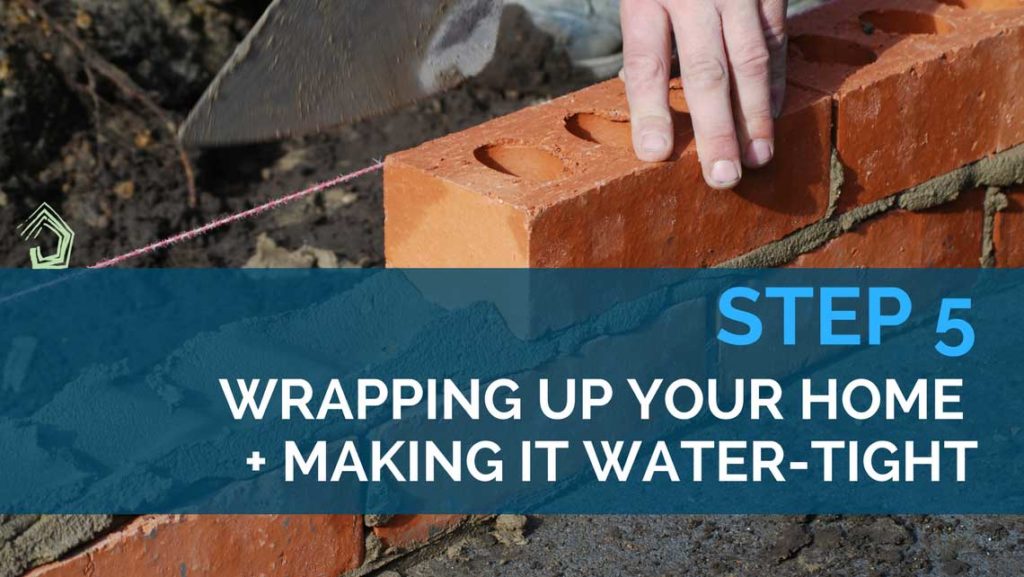
In the next stage of building or renovating your home, we start wrapping things up!
This stage is where you’ll see external wall materials, roofing and internal lining commence on site.
This is STEP 5 in building your new home or renovation project: The Lockup / Enclosed Stage. This stage is a big one.
The race is on to make your home water-tight, so that work can continue inside and be unimpeded by weather conditions.
There can be a difference between what ‘lockup’ and ‘enclosed’ means in your contract. Be sure to understand what this stage will entail for your project. Also be sure to inform your bank so that draws will be paid as required, and stage of complete work not disputed.
The fascia and gutter of your home will generally be installed before your roof goes one.
Sarking, which is a building paper that goes over the timber or steel frame, will be fixed to ‘wrap’ your home, on both its roof and walls. This does have some insulative quality, but is also required for waterproofing.
Roofing material will go on your home, and external windows and doors will be installed. It’s worth understanding that the frame is the structural component of your home – not the external cladding or brickwork. So, any external doors and windows are fixed to the frame.
Rough-in occurs during this stage.
This is where services such as electrical, plumbing and airconditioning, are run to their required locations prior to the interior walls of the home being lined. Your electrician will need to know the number and position of all light switches, light fittings and any appliances or other electrical items. Your plumber will need to know all your selections for tapware and sanitryware, plus the intended positions of these items as well.
Scaffolding hire is a big cost in a lot of new builds and renovations.
It is required legally when work is happening at specific heights on your project. It is also important to minimise the time it is sitting on site and be strategic about sequencing so scaffolding can be installed when needed. A good quality builder will plan this out so you can keep your scaffolding costs down and maintain access as required.
This stage also involves external painting, which surprises many homeowners. Often there’s the perception that external painting will happen towards then end, as a ‘dressing’ to the home. However, given scaffolding costs, and the need for painters to utilise it on taller homes, external painting occurs as soon as the external cladding is in place. Be sure your exterior colour selections are tested and made prior to this point. Delays now can have dramatic flow-on effects.
Once rough-in has occurred, the internal lining of the home will be installed. This is often plasterboard, and wet area board for your bathrooms. Once the walls are lined, holes will be cut to bring services through. Making changes to these items later will mean expense and delay as lining is removed, reinstated and repaired.
With the outside of your home painted, and the scaffolding removed, other work can continue outdoors such as decking, swimming pool and external hardscape.
DID YOU KNOW?
You pay for all the material you use on your project – including the waste material that ends up in the site bin. Construction is one of the highest waste industries. One way to manage this, and your budget, is to use understand the sizes that materials are available in, and use them efficiently.
For more information check out Season 7 in the “Get it Right” podcast and learn more about the construction of your new home or renovation.
Worried about building your new home or reno?
HOME Method is my flagship online program which uses a structured approach to simplify the process of designing, building, or renovating your home, so that it aligns with your ideal lifestyle in every way.
It’s an online program, community and coaching, built around a simple yet powerful step-by-step process to navigate your project with confidence and clarity. Even if you’ve never renovated or built before.
Head to HOME Method to see more about what’s inside the program, and how it can save you stress and money as you navigate the construction of your reno or new home.
 With over 30 years industry experience, Amelia Lee founded Undercover Architect in 2014 as an award-winning online resource to help and teach you how to get it right when designing, building or renovating your home. You are the key to unlocking what’s possible for your home. Undercover Architect is your secret ally
With over 30 years industry experience, Amelia Lee founded Undercover Architect in 2014 as an award-winning online resource to help and teach you how to get it right when designing, building or renovating your home. You are the key to unlocking what’s possible for your home. Undercover Architect is your secret ally
Leave a Reply